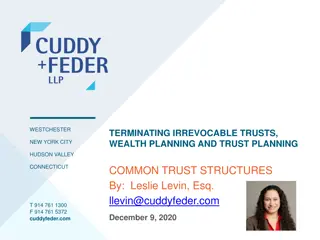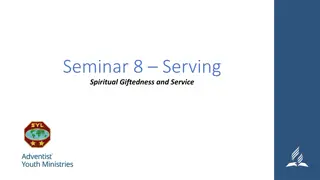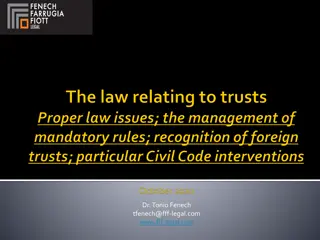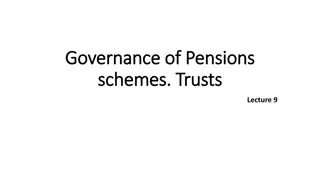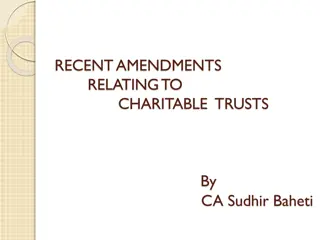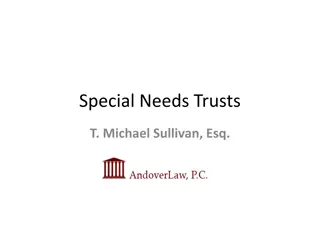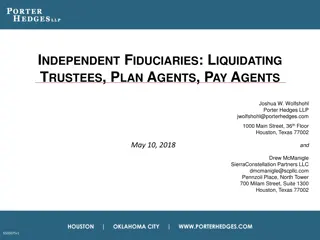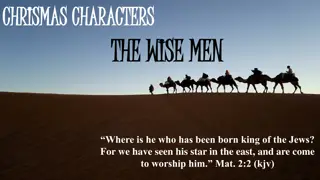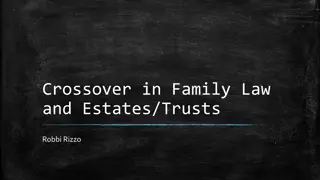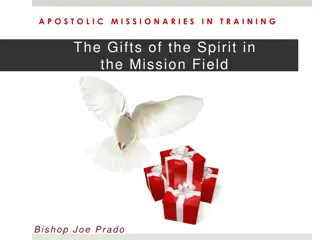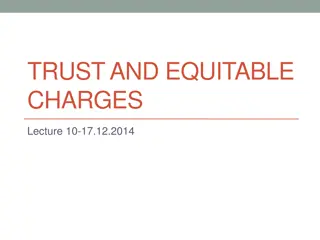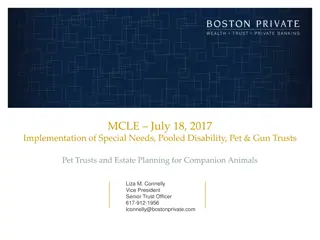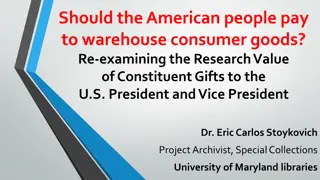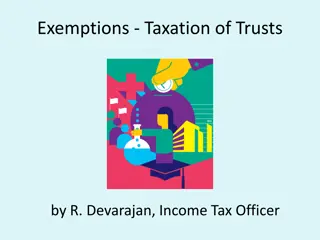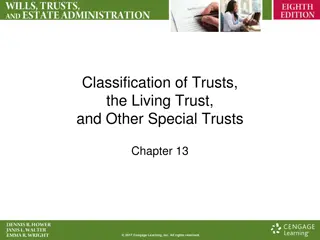Understanding Trusts and Gifts in Family Law
Dive into the intricacies of trusts and gifts in family law, exploring topics such as beneficial interests, equitable remedies, trust types, and their significance in property division for common law relationships. Gain insight into the legal complexities surrounding asset ownership and division in Ontario.
Download Presentation

Please find below an Image/Link to download the presentation.
The content on the website is provided AS IS for your information and personal use only. It may not be sold, licensed, or shared on other websites without obtaining consent from the author. Download presentation by click this link. If you encounter any issues during the download, it is possible that the publisher has removed the file from their server.
E N D
Presentation Transcript
1 Trusts and Gifts What s mine is mine and what s yours is mine too . Ken Nathens & Glen Schwartz Nathens, Siegel Barristers LLP with assistance from Anastasia Toma
2 "Our House * I'll light the fire, you place the flowers in the vase that you bought today. Staring at the fire for hours and hours while I listen to you Play your love songs all night long for me, only for me. Come to me now and rest your head for just five minutes, everything is good. Such a cozy room, the windows are illuminated by the Sunshine through them, fiery gems for you, only for you. Our house is a very, very fine house with two cats in the yard, life used to be so hard, Now everything is easy cause of you and our la, la, la: Our house is a very, very fine house with two cats in the yard, life used to be so hard, Now everything is easy cause of you and our I'll light the fire, you place the flowers in the vase that you bought today. -*Crosby, Stills, Nash and Young
3 Introduction: What is a Trust? A beneficial interest in a property Beneficial Interests (interest not on title) vs. Legal Interests (interest is on title) Purpose of a Trust? Fills a gap in the legislation through the common law Equitable remedy: provides equity in what otherwise would be unequitable situation
4 Why do Trusts Matter in Family Law? 1. Property division is not straightforward (Even for married couples where equalization rules apply) 2. Equalization rules do not apply to common law spouses in Ontario (no inherent right to divide property!)
5 Types of Trust Interests 1. Constructive Trusts (unjust enrichment remedy) 2. Resulting Trusts 3. Proprietary Estoppel (A trust-like remedy) See our article here: Trust Me, this Property is Mine
6 Part I-Constructive Trusts for Common Law Relationships Constructive Trusts Definition: Imposed without reference to the parties intentions An equitable response to a state of affairs Constructive Trusts are a remedy for the cause of action of Unjust Enrichment Can be applied to situations where a contribution is made overtime (e.g. paying for renovations or towards maintenance)
7 Common Law Relationships What is meant by common law : No statutory definition of common law for purposes of family law property division: FLAdefines spouse for purposes of support obligations under Part III of the FLA as follows: spouse : means a spouse as defined in subsection 1 (1), and in addition includes either of two persons who are not married to each other and have cohabited, (a) continuously for a period of not less than three years, or (b) in a relationship of some permanence, if they are the natural or adoptive parents of a child. ( conjoint ) R.S.O. 1990, c. F.3, s. 29; 1999, c. 6, s. 25 (2); 2005, c. 5, s. 27 (4-6); 2009, c. 11, s. 30
8 Definition-continued Aldridge v. Bulko, 2006 CarswellOnt 7386 (support case) Based on this authority and the analysis contained therein, I am of the opinion that sexual intercourse is not an essential component in finding that these parties have cohabited within the meaning of the Family Law Act. They lived together as man and wife and as father and mother to Michael. They held themselves out to the community and to their relatives as a family. They went to the cottage together. Each contributed from their income to sustain the family unit. They lived together under the same roof. They slept in the same bedroom. They had an intimate relationship even though it did not often involve sexual intercourse. They had strong feelings of mutual commitment and support. They communicated on a personal level and ate meals together. They bought gifts for each other on special occasions. They worked together in domestic chores. There is no question that there has been cohabitation between the applicant and the respondent within the meaning of the Family Law Act. I conclude that the applicant is a spouse within the meaning of section 29 of the Family Law Act.
9 Other Cases: Need not even reside in same residence A few cases when older couple maintained separate homes, sometimes in same complex Fluid definition with very fact based analysis Courts have referred to a list of factors but note that not all of them need to be present and can be present in varying degrees: Shelter (did they live under the same room? What were the sleeping arrangements?) Services (preparation of meals; shopping; washing clothes; etc.) Social/ Societal (how did the couple participate in the community? How did they treat each other s family? How did the community perceive them?) Economic Support (what were the financial arrangements?) See the full list: Yonathan v Matrook, 2015 ONSC 1984 (CanLII) Objective contemporaneous evidence is more probative of the nature of the parties' relationship than the viva voce evidence of the parties in the midst of acrimonious and bitter proceedings Para 118 - Macmillan-Dekker v. Dekker, 2000 CanLII 22428
10 Why Are Common Law Property Rights an Issue? Common law rights defined for spousal support, pension division, insurance claims, tax etc. see Legacy of Walsh v. Bona, page 7 Family Law Act, section I-complete regime for matrimonial property division for married parties only. Section 1 spouse definition for property division: must be (a) married to each other, (b) have together entered into a marriage that is voidable or void, in good faith on the part of a person relying on the clause to assert a right.
11 Therefore, common law property rights are an issue because there is no statutory basis for them, thus have to revert to common law. Very unique situation in our day and age. Ultimately, common law couples do not know specifically what property regime will govern their relationship, or how their property will be divided on separation, until after the separation, whether by agreement or court proceedings involving high costs and high risks Alternative: Domestic contract (Cohabitation agreement) S. 53 FLA
12 Constructive Trust: Evolution Murdoch v. Murdoch: [1975] 1 S.C.R. 423 Breakthrough case, not for majority decision, but for minority decision of Justice Laskin. Facts: Parties were married for 25 years, 1943-1968. Husband had ownership interest in family ranch.
13 Murdoch v. Murdoch, [1975] 1 SCR 423 Wife claimed an undivided one-half interest in the ranch. She claimed that a partnership existed between herself and the husband, and as such, the husband held the land and other assets as trustees for parties equally. Evidence showed that, in addition to doing the usual work of a farm wife the wife worked in the fields, operated farm machinery, and contributed to the fund realized from the sale of grain and live stock, which was used to pay for the property. She helped build the house. Because of her work on the farm, no hired man was employed. The husband was frequently ill and she performed the extra duties acknowledged that the farm was run as a team . required. Husband
14 The Murdochs
15 Murdoch v. Murdoch, [1975] 1 SCR 423 Majority Decision: Wife has no beneficial (ownership) interest in property. Interpretation: Wife did not do more than ordinaryrancher s wife is expected to do. As per Husband Most of them can do most anything Minority Decision: Laskin J. impressed by Wife s physical labour that she contributed to family well being as well as modest financial contribution to family enterprise. Paragraph 75: I would declare that the wife is beneficially entitled to an interest in the property and the husband is under the obligation as a constructive trustee to convey the interest to her. Result: Public Outcry-Passing of Family Law Property Legislation, FLRA in 1978 and other provinces. Strictly speaking not common law case, however, as a result of enactment of legislation for family law couples thereafter, principles discussed in Murdoch applicable to common law couples regarding financial contributions and beneficial interests.
16 Peter v Beblow, [1993] 1 SCR 980 Unlike Murdoch, deals specifically with common law couples. Facts: common law relationship for 12 years. Wife looked after home and children (both sets), she cooked, cleaned, washed clothes, looked after garden, looked after property etc. The household duties were not paid. Parties separate, Wife claims constructive trust interest in one half of the property in which parties lived.
17 Peter v Beblow, [1993] 1 SCR 980 Trial Judge: Agreed to Wife being granted constructive trust interest. Husband would be unjustly enriched if obtained benefit of Wife s service without compensation. Trial judge found Wife was under no obligation to do the work without expectation of compensation. BCCA denied claim, stated that Wife had no reasonable expectation of compensation, she was not deprived, and there was insufficient nexus between her contribution and property.
18 Peter v Beblow, [1993] 1 SCR 980 S.C.C: Unjust enrichment proven Three elements: 1) an enrichment; 2) a corresponding deprivation; 3) absence of juristic reason for the enrichment. (see also Pettkus v Becker, [1980] 2 SCR 834-SCC recognizes Constructive trust as an award for unjust enrichment)
19 Peter v Beblow, [1993] 1 SCR 980 Once unjust enrichment is established, there could be either a monetary or property award. Constructive trust arises where it may be proven that monetary damages may not be adequate and there is a link between the contribution that founds the action and the property in which the constructive trust is found. juristicreason : any legal reason why husband should maintain benefit. For example, marriage contract or whether domestic services were gift . Important case that recognizes domestic services in themselves may form basis for constructive trust. No implied obligation to perform such services with no expectation of compensation.
20 According to S.C.C. in Peter v Beblow: Monetary award may be sufficient for a short-term common law relationship, if entitlement under unjust enrichment is small, or if contributions not all that linked to property in question. Court s preference regarding award-split: Cory J (Flexible approach): in order for constructive trust to be applied, monetary relief must be inadequate and there must be a contribution that was sufficiently substantial and direct to entitle the claimant to a portion of the profits realized upon the sale of the property. McLachlin J: prefers value survived approach-more consistent with doctrine of unjust enrichment and constructive trust. Not every contribution will entitle a spouse to one-half interest. The extent of the interest must be proportionate to the contribution, direct or indirect, of the claimant. Where the contributions are unequal, the shares will be unequal.
21 Confusing concept that will be an issue for years to come: Whether monetary award would be adequate. Referred to quantum meruit, or monetary award that is related to value of services provided as opposed to value of property. Concept of employee versus owner. Is pay back in monetary terms sufficient for domestic labour or does deprived party always get piece of the real estate or property? Is there a difference?
22 ONTARIO APPROACH PRIOR TO Kerr v Baranow: VALUE RECEIVED Practical difficulties of the Value Received approach Example: page 23: The Legacy of Walsh v. Bona paper-McLean v. Danicic 2009 Carswell Ont 3289. Determination of calculation of value of services for value received approach. Difficult process-Litigation nightmare.
23 THIS BRINGS US TO .Kerr v Baranow Kerr v Baranow, 2011 SCC 10 and its companion case, Vanesse v Seguin, 2011 SCC 10. Significant in that the case develops concept of unjust enrichment, promotes concept of joint family venture , and stresses importance of value survived remedy, and not value received. Case does not, however, extend common law property rights beyond concept of constructive trust, does not provide remedy for common law spouses who are not able to prove constructive trust claim. Therefore, this case is evolutionary and not revolutionary .
24 Kerr v Baranow, 2011 SCC 10 Kerr v Baranow was supposed to bring clarity into the law of constructive trust and facilitate legal proceedings with concept of JFV and value survived award. Questionable whether it facilitates the litigation process or burden of proof on one claiming constructive trust. Key points of Kerr v Baranow, page 27 of Legacy of Walsh and Bona paper. 1) Value survived is the way to go- This may mean a monetary award if monetary award is appropriate as opposed to an interest in property, but the monetary award is not limited to fee for service approach (quantum meruit). 2) Concept of Joint Family Venture When does JFV exist?
25 Joint Family Venture Components of what makes up a Joint Family Venture: See: David Frenkel s article, Joint Family Venture: A Synthesis of the Post-Kerr Case Law, 34 CFLQ 35 [2014] page 4 (Available on WestLaw): (1) Mutual effort (2) Economic Integration (3) Intent (4) Priority of the Family (5) Mutual Benefit Conferral (6) Reasonable Expectations -
26 Discussion of Evidentiary Burden Justice Cromwell: Once a JFV is determined to exist, there should be no need to engage in an artificial balance sheet approach which does not reflect the true nature of the relationship. The monetary remedy must match, as best as it can, the extent of the enrichment unjustly retained by the defendant. ..when the parties have been engaged in a JFV, and the claimant s contributions to it are linked to the generation of wealth, a monetary award for UE should be calculated according to the share of the accumulated wealth proportionate to the claimant s contributions. What does this mean???
27 Kerr v Baranow does not address the following issues: i. For what assets can a JFV be stated to exist-Business? RRSPs? Pensions? Not clear. Glen will address this. Period of time for which JFV is stated to exist? iii. Mutuality of Benefits-How is this calculated. At what stage is this analyzed-Claim? Defence? Award calculation iv. How do we value benefits conferred? How do lawyers give cost/benefit analysis to clients? v. Does concept of JFV increase certainty, reduce litigation? Is judicial discretion a good thing? ii.
28 Result: Some Uncertainty But Also Greater Predictability Post Kerr v. Baranow, continued uncertainty regarding the law of constructive trust in family context. Courts apply some aspects of JFV, ignore others. Difficult to predict what % of value survived will go to the claimant using analysis provided by SCC. But Kerr does provide a framework, issues for court to focus on to determine if JFV exists and SCC does clarify that award is to be commensurate with value provided, not value of services. Concept of JFV-Are courts now applying concept of equalization of NFP process to unmarried couples-Isn t JFV based on same concept of EP?
29 IS JFV-ANOTHER WAY OF SAYING EP? Preamble-FLA Whereas it is desirable to encourage and strengthen the role of the family; and whereas for that purpose it is necessary to recognize the equal position of spouses as individuals within marriage and to recognize marriage as a form of partnership; and whereas in support of such recognition it is necessary to provide in law for the orderly and equitable settlement of the affairs of the spouses upon the breakdown of the partnership, and to provide for other mutual relationships, including the equitable sharing by parents of responsibility for their children obligations in family
30 ULTIMATE IRONY: Common Law Couples Potentially Have Greater Entitlement than married ones(?) Martin v. Sansome, 2014 ONCA 14 Family Farm OCA states trial judge erred, did not consider if monetary award would have been sufficient prior to granting wife an interest in family farm. If monetary award would have been considered, how would the award be calculated? Ontario C.A. quotes McNamee v. McNamee, 2011 ONCA 533 (canLii)
31 Martin v. Sansome, (cont d) In the vast majority of cases, any unjust enrichment that arises as a result of a marriage will addressed through the operation of the EP provisions under the FLA be fully C.A states at paragraph 66 In my view, if UE as a result of the marriage has been found, and it is determined that a monetary damage can suffice, the aggrieved party s entitlement under the EP provisions of the FLA should first be calculated. Where appropriate, s. 5(6) of the FLA, which provides for an unequal division of NFP where equalization would be unconscionable, should be invoked
32 AND NOW GLEN .
33 Application of JFV to Pensions, and RRSPs Can JFV be attributed to an asset that is not real property? YES!! Not many cases, but the concept does apply to all assets. Same analysis exists for all types of property.
34 Pension: Rolley v. Rolley (SCJ 2018) Unsuccessful claim for constructive trust for a pension but thorough review of couple s relationship helpful in applying JFV analysis Parties cohabitated for 21 years and then got married Husband applied for an equal share of wife s pension accumulated during their cohabitation, claiming unjust enrichment Husband argued that there was a JFV on the basis that he assisted the wife to retrain as a nurse, which entitled her to her pension Husband spent time renovating their home (13 years+) but they kept finances separate and Husband did not suffer a deprivation by his wife returning to school (he didn t pay for it). Husband made decision to remain unemployed while wife asked him to work Court found that there was no JFV: parties were financially separate during the time wife attended school; husband did not pay for the wife s education At each stage of the relationship, none of the JFV factors were found
35 RRSP: Szyngiel v. Rintoul (SCJ 2016) Unsuccessful claim for RRSP Parties cohabited for 8 years Woman purchased a property before cohabitation and man did some renovations Man wished to purchase a farm during relationship but did not have the financial means; woman bought it and title was kept in her name Court found no basis for a JFV and no basis for granting the man the RRSPs Very little pooling of efforts and there was segregation of properties, assets and business interests
36 Nathan v. Hoare [2014] ONSC 1820, CarswellOnt 3457 Brief Summary of Facts Parties are in their late 40 s and met while pursuing their undergraduate degrees. They have cohabitated for over 22 years. Parties moved from Ottawa to Toronto in 1990 as a result of a job opportunity for the male spouse. They shared all expenses and paid them from a joint account that each party deposited their income into.
37 Nathan v. Hoare [2014] ONSC 1820, CarswellOnt 3457 Parties had a home together which they held as joint tenants. They jointly contributed to RRSPs in each of their names but as a result of the fact the male spouse did not have a pension for most of the period of cohabitation and had a higher income, more contribution was put towards his RRSPs than the female spouse s. They also held investment accounts (male spouse showed it as his sole asset, but later on conceded it was joint) The female spouse had a pension with Omers.
38 Nathan v. Hoare [2014] ONSC 1820, CarswellOnt 3457 Justice Backhouse did a thorough analysis of the growth of assets of each party during the relationship as well as their incomes. Justice Backhouse went on to conduct an analysis of unjustenrichment (paragraph 23) To allow each to keep the RRSP assets in his or her own name would result in the husband having almost $100,000 more in retirement assets than the wife accumulated during cohabitation . (paragraph 26)
39 Nathan v. Hoare [2014] ONSC 1820, CarswellOnt 3457 I accept the wife s evidence that throughout their relationship, the parties worked together to provide for their future together on the understanding that all of their resources would be available to meet their needs. I find that the husband has been enriched in regards to the RRSPs/pensions, the Transamerica Life insurance policy and the airmiles, that the wife has suffered a deprivation and there is no reason in law or justice for the husband s retention of the benefit . (paragraph 32)
40 NOW BACK TO KEN!
41 Part II: Resulting Trusts Definition: The underlying notion of the resulting trust is that it is imposed to return property to the person who gave it and is entitled to own it beneficially, from someone else who has title to it. Thus, the beneficial interest results (jumps back) to the true owner . Kerr v. Baranow
42 Purpose? The point of the resulting trust is that the transferor is asking for their property back after the transfer has been made Unlike constructive trusts, resulting trusts not applicable in situations where contribution is over time (objectionable transfer must happen at one time)
43 When are Resulting Trusts Applicable? 1. Gratuitous transfer of property from one persons to another. 2. A joint contribution by two partners to the acquisition of property where title is only placed in one parties name.
44 Intentions Matter! Unlike constructive trusts, the intention of the transferor at time of transfer is an important consideration Key inquiry: Did the transferor intend to gift the property at the time of transfer? No? Then it is to be returned the transferor.
45 You Really Shouldn t Have! (Legal Presumption Against Gifts) The law presumes a resulting trust for gratuitous transfers (rebuttal presumption) i.e If one party advances money to another, it is presumed that the second person holds title to the property in trust for the first
46 Section 14 of the Family Law Act Legal presumption against gifts applies to married partners too: 14 The rule of law applying a presumption of a resulting trust shall be applied in questions of the ownership of property between spouses, as if they were not married, except that, (a) the fact that property is held in the name of spouses as joint tenants is proof, in the absence of evidence to the contrary, that the spouses are intended to own the property as joint tenants; and (b) money on deposit in the name of both spouses shall be deemed to be in the name of the spouses as joint tenants for the purposes of clause (a)
47 Timing Matters! Kerr v. Baranow The resulting trust analysis is applied only to claims arising at the time the property was acquired Examples where resulting trusts CAN T apply: Paying down a mortgage in multiple payments Contributions to maintenance of the property ( renovations or paying condo maintenance fees) Apply constructive trust analysis in these cases, above. Examples where it CAN apply: Transferring title to a home to your partner without consideration Contributing towards a down payment for a home you re not on title for
48 Recent Cases Sorel v. Crane (2018 ONSC 346): Friend ,Tenant or Partner? Parties were two friends (although women alleged they were common law partners; court found it wasn t determinative of her rights; see paragraph 26) they contributed $10,000.00 each for a down payment on a home. Male party was the only registered owner. Parties lived together until male party moved out in 2008, female party remained in the home. Man alleged that women s down payment was a loan, already repaid to her and she was a tenant. Woman claimed the home was purchased for her. On summary judgment, court found woman had a 50% beneficial interest by way of resulting trust and rejected claims she was a tenant despite the fact that she claimed tax credits for rental payments to the male party. Angeloni v. Angeloni (2017 ONSC 7344): A Favorite Niece Husband had moved his wife into a long term care facility and severed joint tenancy of their family home and converted into tenancy in common under a power of attorney Home was sold and husband deposited proceeds into parties joint account: he later gave part of proceeds to his niece. He died 19 days later without providing for wife in his will. Court found that there was a gratuitous transfer from the wife to the husband, and further from the husband to the niece with respect to the proceeds of the home sale. Money belonged to the Widow and not niece. Niece, as husband s estate trustee was ordered to provide accounting of management of the estate to the Widow.
49 Recent Cases Cont d Malkov v. Stovichek-Malkov 2017 ONSC 6822*: Generous Grandpa Parties were married for 6 years and husband s father owned the property where they first resided When first property was sold, husband s father allowed the parties to live in another property he owned; he transferred title to the husband and wife Court found that there was a resulting trust for the husband s father Context: Husband s father paid for most of the couples expenses while they were married, including their children s private school tuition. *Case recently reaffirmed in Malkov v. Stovichek-Malkov 2018 ONCA 620
50 Recent Case from our Firm Client allowed his son and wife to live in a condo he owned while they saved for their own home Client had purchased home as a retirement property Son and daughter-in-law separated; as a part of the family law proceedings daughter-in-law claimed that she had a 50% beneficial interest in client s home by way of resulting or constructive trust


